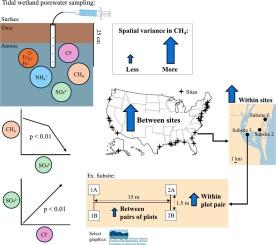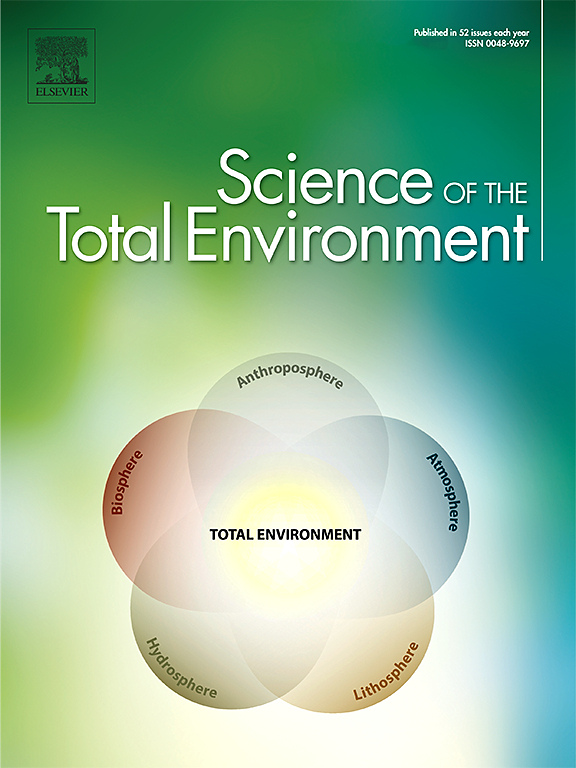美国潮汐湿地孔隙水甲烷浓度空间变化的控制因素。
IF 8
1区 环境科学与生态学
Q1 ENVIRONMENTAL SCIENCES
引用次数: 0
摘要
潮汐湿地可以成为大量温室气体的吸收汇,但在某些环境条件和人为干预下,潮汐湿地的甲烷(CH4)排放量可能会被抵消。土地管理者和政策制定者需要潮汐湿地 CH4 属性的地图,以便做出恢复决策和清查温室气体。然而,基于点的孔隙水 CH4 浓度及其预测因子采样与用于放大这些数据的更高分辨率制图产品在空间尺度上不匹配。我们对美国 27 个潮汐湿地的孔隙水 CH4 浓度、盐度、硫酸盐 (SO42-)、铵 (NH4+) 和总铁进行了空间分层取样。我们测量了四个数量级(0.05 至 852.9 μM)的孔隙水 CH4 浓度。空间尺度对地点间和地点内 CH4 差异的相对贡献最大。SO42- 浓度对孔隙水 CH4 浓度的解释效果最好,分段线性回归结果(p 2 = 0.54)表明,在 SO42- 浓度低于 0.62 mM 时,CH4 对 SO42- 的敏感性较低。盐度与 SO42- 高度相关(p 2 = 0.909),因此是 CH4 浓度的重要替代指标。然而,与 SO42- 相比,盐度在分段线性回归中对 CH4 的预测性较低(p 2 = 0.319)。NH4+、总铁和相对潮汐高程均与孔隙水 CH4 无显著相关性;然而,在对 CH4 与 SO42- 的关系进行去趋势分析后,NH4+ 与 SO42- 呈显著正相关(p 2 = 0.194)。未来的取样工作应重点关注站点内和站点间的环境梯度,以准确绘制 CH4 变化图。绘制子流域尺度的盐度图在绘制 SO42- 图方面具有一定的潜力,并可通过代用图制约孔隙水 CH4 浓度的空间变化。要解释盐度-硫酸盐关系在地点层面的偏差并阐明甲烷生成的其他预测因素,还需要做更多的工作。这项工作展示了一种独特的远程团队科学方法,以及加强合作研究网络的潜力。本文章由计算机程序翻译,如有差异,请以英文原文为准。

Controls on spatial variation in porewater methane concentrations across United States tidal wetlands
Tidal wetlands can be a substantial sink of greenhouse gases, which can be offset by variable methane (CH4) emissions under certain environmental conditions and anthropogenic interventions. Land managers and policymakers need maps of tidal wetland CH4 properties to make restoration decisions and inventory greenhouse gases. However, there is a mismatch in spatial scale between point-based sampling of porewater CH4 concentration and its predictors, and the coarser resolution mapping products used to upscale these data. We sampled porewater CH4 concentrations, salinity, sulfate (SO42−), ammonium (NH4+), and total Fe using a spatially stratified sampling at 27 tidal wetlands in the United States. We measured porewater CH4 concentrations across four orders of magnitude (0.05 to 852.9 μM). The relative contribution of spatial scale to variance in CH4 was highest between- and within-sites. Porewater CH4 concentration was best explained by SO42− concentration with segmented linear regression (p < 0.01, R2 = 0.54) indicating lesser sensitivity of CH4 to SO42− below 0.62 mM SO42−. Salinity was a significant proxy for CH4 concentration, because it was highly correlated with SO42− (p < 0.01, R2 = 0.909). However, salinity was less predictive of CH4 with segmented linear regression (p < 0.01, R2 = 0.319) relative to SO42−. Neither NH4+, total Fe, nor relative tidal elevation correlated significantly with porewater CH4; however, NH4+ was positively and significantly correlated with SO42− after detrending CH4 for its relationship with SO42− (p < 0.01, R2 = 0.194). Future sampling should focus on within- and between-site environmental gradients to accurately map CH4 variation. Mapping salinity at sub-watershed scales has some potential for mapping SO42−, and by proxy, constraining spatial variation in porewater CH4 concentrations. Additional work is needed to explain site-level deviations from the salinity-sulfate relationship and elucidate other predictors of methanogenesis. This work demonstrates a unique approach to remote team science and the potential to strengthen collaborative research networks.
求助全文
通过发布文献求助,成功后即可免费获取论文全文。
去求助
来源期刊

Science of the Total Environment
环境科学-环境科学
CiteScore
17.60
自引率
10.20%
发文量
8726
审稿时长
2.4 months
期刊介绍:
The Science of the Total Environment is an international journal dedicated to scientific research on the environment and its interaction with humanity. It covers a wide range of disciplines and seeks to publish innovative, hypothesis-driven, and impactful research that explores the entire environment, including the atmosphere, lithosphere, hydrosphere, biosphere, and anthroposphere.
The journal's updated Aims & Scope emphasizes the importance of interdisciplinary environmental research with broad impact. Priority is given to studies that advance fundamental understanding and explore the interconnectedness of multiple environmental spheres. Field studies are preferred, while laboratory experiments must demonstrate significant methodological advancements or mechanistic insights with direct relevance to the environment.
 求助内容:
求助内容: 应助结果提醒方式:
应助结果提醒方式:


